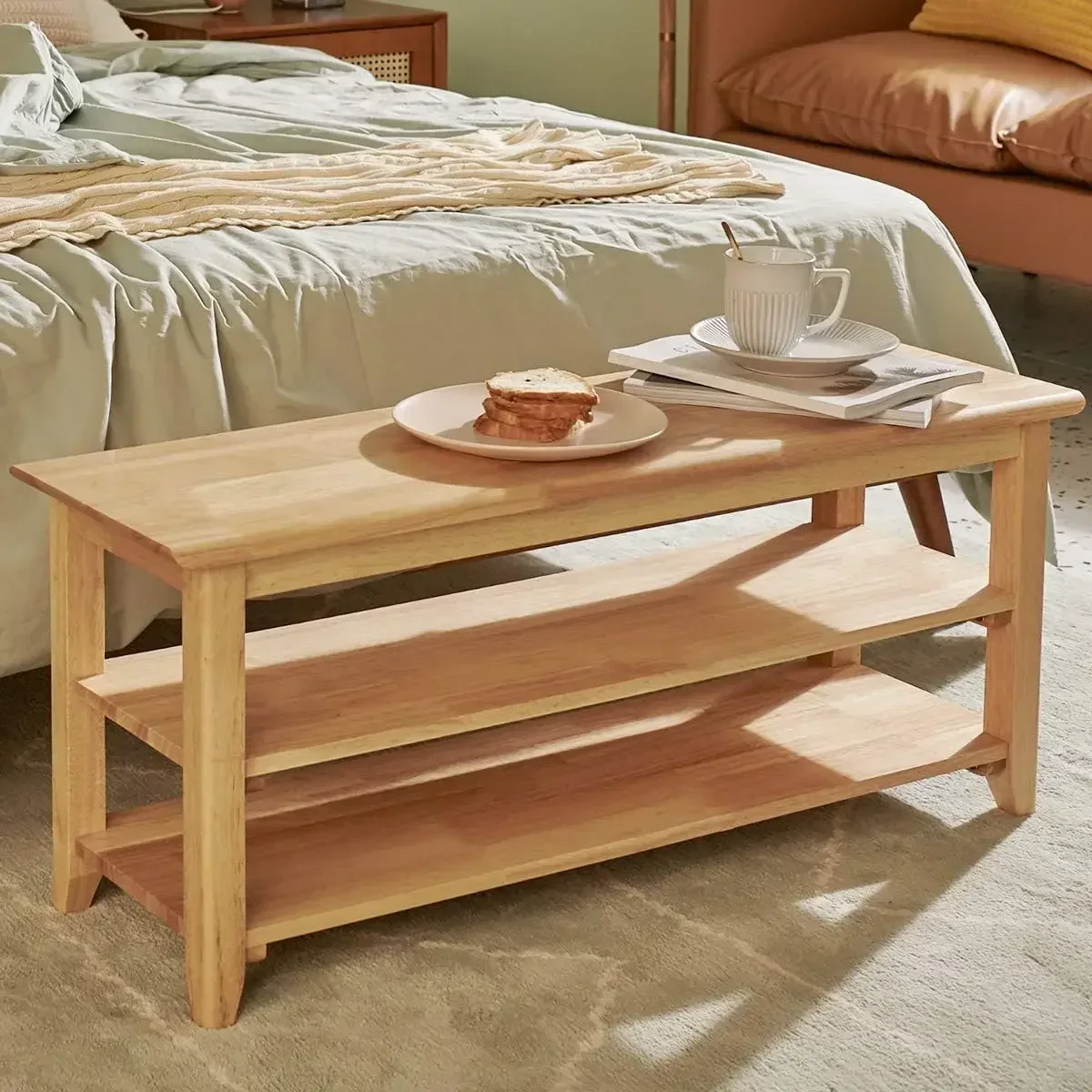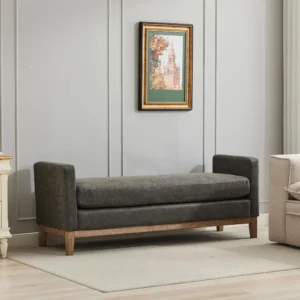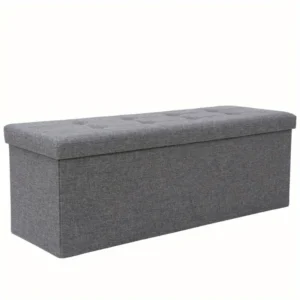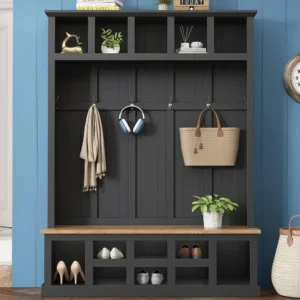The Essential Role of Seating in Your Foyer
Your foyer is more than just an entrance—it’s the transitional space between outdoors and indoors, where daily comings and goings create a natural hub for organization. This high-traffic area deserves thoughtful planning, especially when it comes to seating options that can withstand the daily ritual of removing and putting on shoes.
“Shoe-friendly” seating isn’t just about durability—it’s about creating a comfortable spot at the right height for easily changing footwear, while also serving as a design element that enhances your home’s first impression. The average person spends nearly 5 minutes each day putting on and removing shoes, making ergonomic considerations particularly important for this everyday activity.
Finding the right balance between practicality and style can transform your entryway from a chaotic collection point into an organized, welcoming space. Whether your home accommodates a spacious mudroom or a compact apartment entry, there are entryway furniture options with shoe compartments designed to meet your specific needs.
Throughout this guide, we’ll explore various seating solutions that combine comfort, durability, and organization—from multi-functional storage benches to space-saving alternatives—all designed to bring order to one of your home’s busiest areas.
Key Qualities of Durable Foyer Seating
When selecting seating for your entryway, certain qualities transform ordinary furniture into truly “shoe-friendly” options that will stand the test of time. Understanding these essential characteristics helps ensure your investment remains functional for years to come.
First and foremost, durability stands as the cornerstone requirement. Entryway furniture endures consistent weight-bearing stress, exposure to outdoor elements, and potential scuffing from shoes. Look for:
- Reinforced joinery and construction that can support at least 250-300 pounds for average households
- Scratch-resistant surfaces that won’t show damage from shoe contact
- Moisture-resistant materials that can handle wet boots or umbrellas
- Easy-to-clean surfaces that don’t require special maintenance products
The ergonomics of your seating directly impact comfort when changing shoes. The ideal height range falls between 17-19 inches (43-48 cm) from the floor, providing optimal positioning for most adults to comfortably put on and remove footwear without straining.
Stability becomes particularly important when people shift their weight while balancing on one foot. Wide bases, non-slip feet, or wall-attachment options prevent tipping hazards, while strategically placed weight distribution supports various body types and movements.
Finally, consider maintenance requirements before making your selection. Entryway furniture should be easy to clean with simple supplies, making daily or weekly maintenance effortless rather than a chore. Choosing the perfect bench with shoe storage means weighing all these qualities against your specific household needs and entryway constraints.
Best Materials for High-Traffic Entryway Furniture
The material of your foyer seating plays a crucial role in determining how well it withstands the demands of daily use. Each option offers distinct advantages and considerations for entryway environments.
Hardwoods provide exceptional durability and timeless appeal. Options like oak and maple resist denting and scratching, making them ideal for busy households. While more expensive initially, their longevity often justifies the investment:
– Oak: Extremely durable with prominent grain patterns
– Maple: Slightly harder than oak with a smoother, more uniform appearance
– Walnut: Rich, dark tones but requires more maintenance to prevent scratching
Engineered woods and composites offer budget-friendly alternatives that resist warping from moisture exposure:
– Medium-density fiberboard (MDF) with laminate coating provides good durability at lower cost
– Plywood core construction offers better strength-to-weight ratio than solid wood
– Particleboard with quality veneer can be affordable but may show wear faster
Metal elements introduce industrial strength and modern aesthetic:
– Steel frames provide maximum stability and weight capacity
– Wrought iron offers decorative potential with excellent durability
– Aluminum components reduce weight while resisting corrosion
For upholstered options, performance fabrics have revolutionized entryway furniture possibilities:
– Solution-dyed acrylics resist fading and staining
– Polyester blends with stain-resistant treatments withstand heavy use
– Crypton and Sunbrella fabrics offer nearly waterproof protection
Leather and faux leather surfaces can be wiped clean easily:
– Full-grain leather develops character with age but requires occasional conditioning
– Top-grain leather offers better stain resistance with less maintenance
– Quality vinyl alternatives provide similar benefits at lower cost
When selecting materials for your entryway, consider your household’s specific challenges. Families with children might prioritize stain resistance, while homes in rainy climates need materials that can handle moisture exposure. Ultimate guides to durable mudroom seating often recommend combinations of materials that address multiple needs simultaneously.
Storage Benches: The Multi-Purpose Solution
Storage benches represent perhaps the most versatile and practical solution for entryway seating needs. These multi-functional pieces solve two challenges simultaneously: providing comfortable seating for shoe changes while offering dedicated space to store footwear and accessories.
The design variations of storage benches allow for customization based on your specific organizational preferences:
Flip-top storage benches provide a clean, streamlined appearance with hidden storage underneath the seat. This design works exceptionally well for storing seasonal items or less frequently used footwear while maintaining a tidy appearance. The hinged top typically includes safety features to prevent accidental closing.
Cubby-style open storage benches feature divided compartments beneath or beside the seating surface. This design allows for better air circulation around shoes—an important consideration for preventing odors. Many homeowners appreciate the visual organization that cubbies provide, with each family member having designated spaces.
Drawer-based storage benches slide out horizontally rather than opening from the top, making them ideal for spaces where overhead clearance is limited. Drawers also tend to contain dust better than open storage options.
Storage capacity varies significantly between models. A typical three-foot bench with open cubbies accommodates 6-9 pairs of adult shoes, while larger designs can store 12+ pairs. When evaluating storage benches for your space, consider both current needs and seasonal variations in footwear volume.
Ventilation deserves special attention when selecting enclosed storage designs. Shoes naturally retain moisture, which can lead to unwanted odors or even mildew in completely sealed environments. Look for designs with subtle airflow features like slotted sides or backs, particularly for storing athletic shoes or boots.
For homes with multiple family members, entryway benches with shoe storage that feature divided sections help maintain organization by providing clear boundaries between each person’s belongings. Many homeowners find that this simple organizational strategy significantly reduces morning chaos and misplaced items.
The versatility of storage benches extends beyond shoe storage—many designs incorporate additional features like coat hooks, umbrella stands, or adjustable shelving to create comprehensive entry benches with shoe storage solutions for diverse household needs.
Simple Entryway Benches: Elegant Minimalism
For those who value clean lines and uncluttered spaces, simple entryway benches offer elegant functionality without the bulk of integrated storage. These streamlined seating options focus on comfort and design while complementing other organizational elements in your foyer.
The primary advantage of simple benches is their versatility in smaller spaces or architecturally distinctive entryways. With typical dimensions ranging from 36-48 inches (91-122 cm) wide and just 14-16 inches (36-41 cm) deep, these benches can fit in narrow hallways or compact foyers where bulkier storage benches might overwhelm the space.
Design variations abound in this category, including:
– Backless benches that can float in the center of larger entryways
– Corner designs that maximize awkward angular spaces
– Floating wall-mounted options that create an airy, contemporary feel
– Traditional farmhouse styles with subtle decorative elements
While these benches lack built-in shoe storage, they pair beautifully with separate organizational components like shoe cabinets, decorative baskets, or wall-mounted racks. This separation actually offers greater flexibility in how you arrange your entryway.
For enhanced comfort, many homeowners add cushions to wooden or metal benches. Entryway benches with cushions provide a softer seating surface while introducing color and texture to the space. Look for cushions with removable, washable covers in durable fabrics like canvas, microfiber, or indoor/outdoor materials for maximum practicality.
Simple benches also tend to be more affordable than their storage-integrated counterparts, making them an excellent choice for budget-conscious decorators or those who prefer to invest in statement pieces elsewhere in their home.
Despite their minimalist approach, these benches still need to meet the fundamental requirements of durability and stability for daily shoe changes. Look for solid construction with reinforced joinery and non-slip feet to ensure safety during use.

Mudroom Lockers with Integrated Seating
For larger households or families with active lifestyles, mudroom lockers with integrated seating represent the ultimate organizational solution. These comprehensive systems combine bench seating with vertical storage components to create designated zones for each family member’s outerwear, footwear, and accessories.
The defining feature of mudroom locker systems is their vertical integration of multiple storage types:
– Lower bench seating with shoe storage underneath
– Upper cabinets or shelving for seasonal items
– Individual cubbies or compartments for personal belongings
– Coat hooks positioned at appropriate heights for different family members
– Optional features like mail slots, key hooks, or charging stations
Space requirements for these systems are more substantial than simple benches or storage ottomans. A basic three-person mudroom locker typically requires a wall space at least 4-5 feet (122-152 cm) wide and 7 feet (213 cm) tall, with depth dimensions of 16-18 inches (41-46 cm). Larger households may need configurations spanning 6-8 feet (183-244 cm) or more.
Installation considerations include secure anchoring to wall studs, level flooring, and sometimes electrical access for integrated lighting or charging stations. While some systems come as ready-to-assemble furniture pieces, others require permanent installation more akin to cabinetry.
The organizational benefits of these systems are substantial, particularly for households with children. Designated spaces for each person’s belongings eliminate the “where are my shoes?” morning scramble and create natural habits of organization from an early age.
Materials for mudroom benches with shoe storage typically emphasize maximum durability, with solid wood, high-quality plywood, or metal frameworks being the most common choices. Finishes tend toward the practical rather than delicate, with wipe-clean paints, stains, or laminates dominating the market.
While representing a larger investment than single-purpose seating options, mudroom lockers offer comprehensive organization that can transform how your household manages the daily transition between indoor and outdoor activities.
Space-Saving Alternatives: Ottomans and Stools
Not every home has the luxury of a spacious foyer. For apartments, condominiums, and smaller homes, compact seating solutions provide essential functionality without overwhelming limited entryway space. Ottomans and stools offer versatile alternatives that maintain comfort while minimizing footprint.
Storage ottomans represent perhaps the most efficient use of space, with typical dimensions of just 16-20 inches (41-51 cm) square or round. These multipurpose pieces offer:
– Hidden interior storage accessible through a removable top
– Soft seating suitable for shoe changes
– Portability to relocate as needed
– Decorative potential with various upholstery options
Weight capacity remains an important consideration even with smaller pieces. Quality storage ottomans should support at least 200-250 pounds (91-113 kg) to accommodate adults safely. Look for internal frames made of hardwood or thick plywood rather than particleboard for adequate stability.
Nesting stools provide another space-conscious option, with sets of 2-3 different-sized stools that stack together when not in use. These can be distributed throughout the entryway when multiple family members are preparing to leave simultaneously, then neatly combined when not needed.
For extremely limited spaces, fold-down wall-mounted seating offers the ultimate space efficiency. These installations remain flush against the wall when not in use, extending only during shoe changes. While requiring more complex installation, they provide seating with virtually zero footprint impact.
Modern seating for small foyers often incorporates dual-functionality beyond just storage—serving as side tables, display surfaces, or even pet beds when not used for human seating. This versatility makes them excellent investments for adaptable living spaces.
When selecting compact seating for your entryway, consider the proportions of your space carefully. Even in small areas, small shoe benches that appear properly scaled to the room create more visual harmony than pieces that seem either too large or too diminutive for their surroundings.
Wall-Mounted and Floating Bench Options
Wall-mounted seating brings a contemporary aesthetic and practical advantages to modern entryways. These floating designs create an illusion of spaciousness while providing the same functional benefits as traditional floor-standing benches.
The key advantage of wall-mounted options is floor clearance, which offers multiple benefits:
– Unobstructed floor space for easier cleaning
– Visual lightness that makes small spaces feel larger
– Modernist aesthetic that complements contemporary interiors
– Ability to install at custom heights for household members
Installation requirements deserve careful attention, as these benches must support considerable weight through wall attachments alone. Critical considerations include:
– Mounting into wall studs or using appropriate heavy-duty anchors
– Weight capacity typically limited to 250-300 pounds (113-136 kg)
– Reinforced mounting brackets or French cleat systems for maximum stability
– Professional installation recommended for safety
Most floating benches range from 36-48 inches (91-122 cm) in width, with depths of 12-16 inches (30-41 cm)—slightly narrower than their floor-standing counterparts to maintain proper proportion and reduce leverage forces on wall mounts.
Materials for these installations tend toward the lighter end of the spectrum, with aluminum frames, engineered woods, or composite materials being common choices. Solid hardwoods appear in higher-end designs but require more substantial mounting hardware due to their inherent weight.
Some floating bench designs incorporate subtle storage elements like thin drawers or small shelves that maintain the minimalist aesthetic while providing limited organizational capacity. These hybrid designs bridge the gap between simple seating and storage functionality.
When considering floating bench installations, evaluate your wall construction carefully. Drywall over wooden studs provides ideal mounting conditions, while concrete, brick, or metal stud walls may require specialized hardware or professional assessment to ensure safe installation.
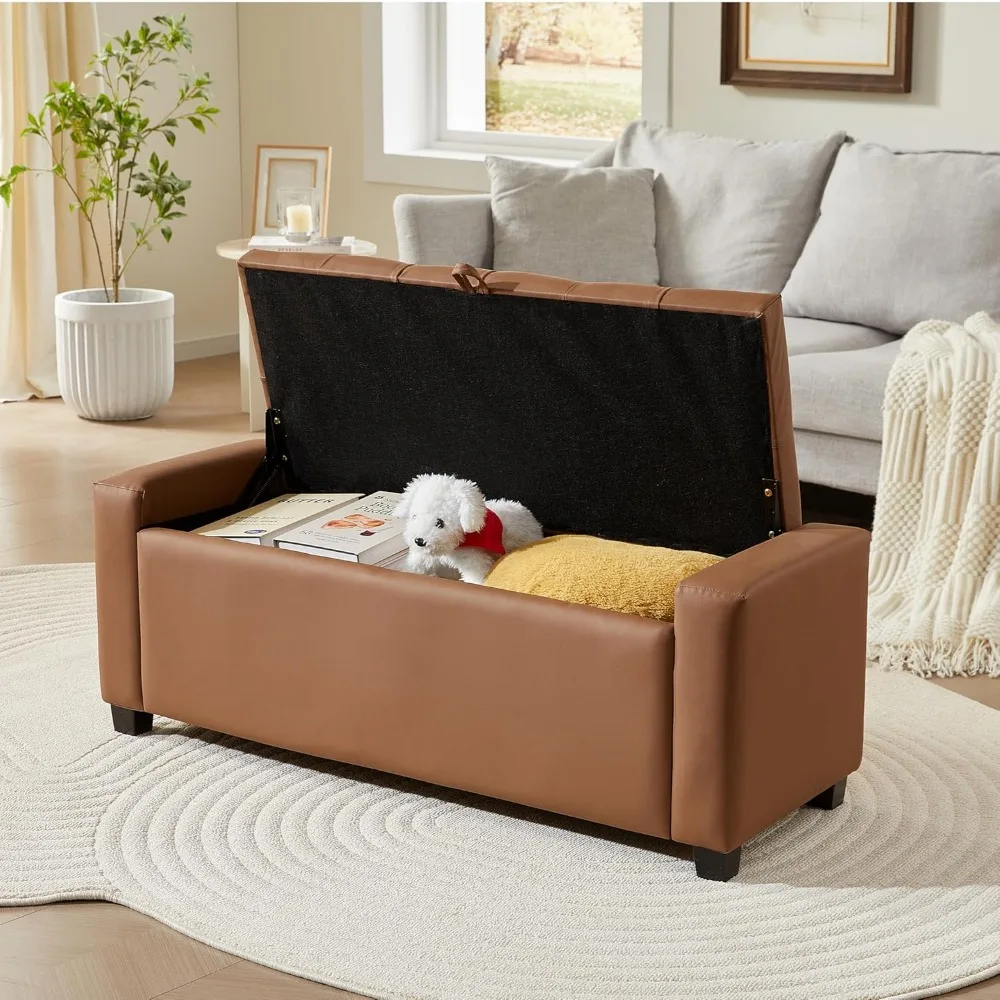
Matching Your Foyer Seating to Home Décor
Your entryway creates the first impression of your interior design aesthetic, making style coordination particularly important when selecting seating. The best foyer furniture bridges outdoor and indoor design elements while establishing the visual tone for your home.
Different architectural styles naturally complement specific seating designs:
Modern/Contemporary Homes benefit from clean lines and minimal ornamentation. Look for:
– Simple geometric forms without decorative flourishes
– Materials like metal, glass, and engineered wood with smooth finishes
– Monochromatic color schemes or controlled contrast
– Hidden storage rather than visible organizational features
Traditional/Classic Interiors call for more detailed craftsmanship:
– Rich wood tones with visible grain patterns
– Gentle curves and subtle decorative elements
– Upholstery with classic patterns like stripes or small-scale prints
– Visible hardware in brass, bronze, or antique finishes
Farmhouse/Rustic Styles embrace natural materials and visible textures:
– Distressed or reclaimed wood with character marks
– Metal accents with matte or aged finishes
– Neutral color palettes with occasional pops of warmth
– Open storage that displays contents as part of the aesthetic
Industrial Designs feature raw materials and structural elements:
– Metal frameworks with exposed fasteners
– Wood with minimal finishing treatments
– Utilitarian approaches to storage and organization
– Darker color schemes with texture variations providing interest
Beyond matching specific styles, consider the color harmony between your seating and adjacent elements like flooring, wall color, and nearby furniture pieces. Modern entryway benches often serve as transitional elements between different design zones in open floor plans.
For maximum design flexibility, consider seating in neutral tones that allows for seasonal accessory changes through cushions, throws, or decorative baskets. This approach provides visual refreshment without replacing furniture pieces.
Remember that entryway seating experiences high visibility but relatively brief use periods—this makes it an excellent opportunity to introduce distinctive design elements that might feel overwhelming in rooms where people spend extended time.
Sizing Your Seating: Measurements That Matter
Selecting properly dimensioned seating ensures both functional comfort and visual proportion in your entryway. Precise measurements before shopping prevent costly mistakes and disappointment with ill-fitting furniture.
Key Dimensions to Consider:
| Measurement Type | Recommended Range | Primary Consideration |
|---|---|---|
| Seat Height | 17-19 inches (43-48 cm) | Optimal for shoe changes |
| Bench Width | 36-60 inches (91-152 cm) | Based on available wall space |
| Seat Depth | 15-18 inches (38-46 cm) | Comfortable support while seated |
| Clearance Space | Minimum 36 inches (91 cm) | Allows for foot traffic flow |
| Storage Capacity | Varies by household | 3-4 pairs per person minimum |
Begin by measuring your available wall space where the seating will be positioned. Remember that the bench should not occupy the entire wall—visual breathing room on either side creates more pleasing proportions. A general rule suggests leaving at least 6-10 inches (15-25 cm) of empty wall space on either side.
Traffic flow consideration is equally important. Measure the distance between your planned seating location and any opposing walls, doors, or furniture. Maintain at least 36 inches (91 cm) of clearance for comfortable passage, with 42-48 inches (107-122 cm) being ideal for high-traffic areas.
For households with taller or shorter members, consider adjusting the standard 17-19 inch (43-48 cm) seat height accordingly. Each inch of height difference significantly impacts comfort during the shoe changing process.
When evaluating storage capacity, a practical approach is to count the actual footwear pairs that need accommodation during your highest-volume season (typically winter, when boots and multiple shoe types are in rotation). Ultimate guides to shoe storage benches often recommend planning for 20% more capacity than your current needs to accommodate guests and future acquisitions.
Remember that visual scale matters alongside functional dimensions. In smaller entryways, a bench exceeding 40% of the available wall width may appear disproportionately large, while expansive foyers might make standard-sized benches appear undersized and insignificant.
Is Your Seating Child and Pet Friendly?
Households with children and pets face unique considerations when selecting entryway furniture. Safety, durability, and cleaning ease become particularly important factors in creating a functional shoe-changing area for the entire family.
What safety features should I look for with young children?
Safety starts with stability—furniture that won’t tip when little ones climb or lean on it. Look for pieces with wide bases, low centers of gravity, or wall-anchoring options. Rounded corners and edges reduce injury risk during active play, while pinch-proof hinges on storage benches prevent small fingers from getting caught.
Which materials best withstand children and pets?
Performance fabrics designed specifically for homes with children offer stain resistance without harsh chemicals. Crypton, Sunbrella, and Revolution fabrics repel liquids and resist staining while remaining soft and comfortable. For non-upholstered surfaces, sealed woods, laminates, or metal frames with powder-coating provide superior resistance to scratches from pet claws or children’s toys.
How can I prevent my storage bench from becoming a toy box?
Clear organizational systems help everyone understand where items belong. Consider seating with divided storage sections—labeled cubbies, color-coded baskets, or designated shoe compartments establish boundaries that even young children can follow. Some designs include childproof latches that prevent unsupervised access to storage compartments.
What about cleaning considerations?
Look for removable, machine-washable cushion covers for inevitable spills. Non-fabric surfaces should withstand disinfecting wipes and pet-safe cleaners without damage. Avoid deep textures or crevices that trap pet hair and dirt; instead, choose smooth surfaces that can be quickly wiped clean.
Are certain designs better for multi-generation households?
Seating with varying heights accommodates different family members comfortably. Some bench designs include both adult-height seating and lower surfaces perfect for children putting on their own shoes. Sturdy armrests or grab bars benefit older adults who may need additional support when sitting down or standing up.
Regardless of specific design choices, entryway furniture in active households should prioritize function over delicate aesthetics, choosing practical finishes and constructing materials that will maintain their appearance despite the daily challenges of family life.
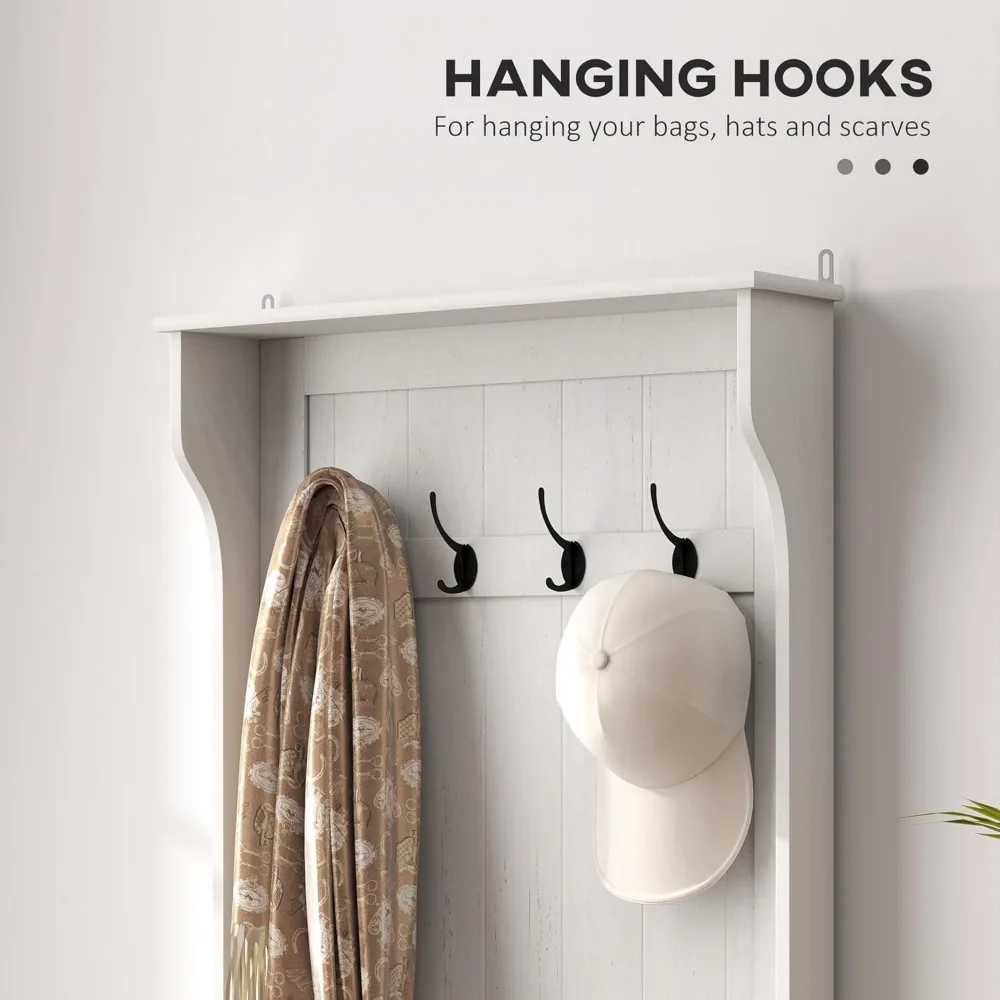
Budget-Friendly DIY Shoe Seating Solutions
Creating custom entryway seating doesn’t always require professional carpentry skills or substantial budgets. Several DIY approaches allow for personalized solutions that perfectly fit your space and organizational needs.
Repurposed Furniture Transformations
Existing furniture pieces can find new life as entryway seating with minimal modifications:
– Kitchen benches or dining banquettes repurposed with water-resistant cushions
– Old dressers with drawers repurposed for shoe storage and tops reinforced for seating
– Headboards mounted horizontally with a platform added to create unique bench designs
– Coffee tables elevated to proper seating height with furniture risers or new legs
Simple Woodworking Projects
Basic carpentry skills can yield impressive custom seating:
– Simple bench designs using 2×10 or 2×12 lumber for the seat and 2×4 supports (approximately $50-75 in materials)
– Cube storage units laid horizontally and topped with cushions for combined storage/seating
– Wall-mounted flip-down seating using piano hinges and folding brackets
– Wooden crates assembled and finished to create modular storage cubes with cushioned tops
Upcycling Opportunities
Creative reuse of materials adds character while reducing costs:
– Vintage trunks or suitcases stacked to proper height and stabilized
– Old doors mounted horizontally on sturdy legs with added cushioning
– Wooden pallets cleaned, sanded, and finished for industrial-style benches
– Repurposed metal lockers with doors removed and seating added inside compartments
When undertaking DIY projects for entryway seating, pay special attention to weight capacity and stability. Reinforcing joints with metal brackets, using proper wood screws rather than nails, and adding cross-bracing significantly improves durability for daily use.
For finishing DIY pieces, several options provide necessary durability for entryway environments:
– Polyurethane or polycrylic clear coats for water resistance on wooden surfaces
– Exterior-grade paint for maximum durability against scuffs and moisture
– Removable cushion covers made from canvas drop cloths or outdoor fabrics
While DIY approaches offer substantial savings, they’re not always the right choice for every household. Those seeking ready-made quality should explore shoe storage bench options that combine professional construction with design versatility.
Entryway Bench with Cushion, Mudroom Bench with Cushion, Shoe Bench for Entryway
$1,186.63 Select options This product has multiple variants. The options may be chosen on the product pageEntryway Bench with Back, Modern Entryway Bench, Shoe Bench for Entryway
Price range: $463.13 through $474.44 Select options This product has multiple variants. The options may be chosen on the product pageEntryway Bench with Shelf Storage, Shoe Bench for Entryway, Shoe Storage Bench
$194.08 Select options This product has multiple variants. The options may be chosen on the product pageCorner Entryway Bench, Entryway Bench with Cushion, Modern Entryway Bench, Shoe Bench for Entryway
$476.34 Select options This product has multiple variants. The options may be chosen on the product pageBench with Hooks and Storage, Entryway Hall Tree, Mudroom Bench with Cubbies, Mudroom Bench with Shoe Storage
$818.38 Select options This product has multiple variants. The options may be chosen on the product pageModern Entryway Bench, Wood Entryway Bench, Wood Mudroom Bench
$497.69 Select options This product has multiple variants. The options may be chosen on the product page
Creating a Complete Foyer Station: Beyond Just Seating
A truly functional entryway combines seating with complementary elements to create a comprehensive organization system. These additional components work alongside your bench or storage ottoman to streamline daily comings and goings.
Vertical Storage Solutions
Maximize wall space above and beside your seating with:
– Wall-mounted coat hooks at appropriate heights for different family members
– Floating shelves for keys, mail, and seasonal accessories
– Cabinets or cubbies for items that benefit from concealed storage
– Pegboard systems that allow for customizable hook arrangements
Floor Protection Elements
Contain moisture and debris from shoes with:
– Durable entry mats with water-trapping capabilities
– Boot trays with raised edges to contain melting snow or rain
– Washable runners that protect flooring while adding decorative elements
– Designated zones for wet footwear separate from clean storage areas
Essential Accessories
Small additions that enhance functionality include:
– Mirror placement for last-minute appearance checks
– Umbrella stands or hooks near the door
– Key storage solutions like magnetic strips or decorative hooks
– Baskets for gloves, scarves, and other small seasonal items
– Lighting that illuminates the area adequately for finding and selecting footwear
The power of a complete system comes from thoughtful integration of these elements. For example, positioning a mirror above your seating creates a natural spot for checking appearance while putting on shoes, while placing boot trays directly adjacent to (not in front of) seating prevents tripping hazards.
Entryway hall trees represent the ultimate all-in-one solution, combining seating, shoe storage, hooks, and sometimes mirrors or shelving in a single coordinated unit. These comprehensive pieces work particularly well in foyers with limited floor space but adequate vertical clearance.
When designing your complete foyer station, consider the natural flow of your family’s routines. Position elements in sequence with typical activities—hooks near the door for immediate coat hanging, seating positioned for comfortable shoe removal, and storage accessible from seated positions for maximum efficiency.
Should You Choose Custom or Ready-Made Seating?
Deciding between custom-built and ready-made entryway seating involves weighing several factors, including budget, timeline, and specific needs of your space.
Ready-Made Advantages:
– Immediate availability for quick home improvements
– Opportunity to see and test the exact product before purchasing
– Generally more budget-friendly price points
– Easier replacement or updating in the future
– Transportability if you move to a new home
Custom-Built Benefits:
– Precise sizing for unusual spaces or specific requirements
– Material selection tailored to exactly match existing décor
– Design features specific to your household’s unique needs
– Potentially higher quality construction with premium materials
– Perfect fit for architectural features like alcoves or irregular walls
From a budget perspective, ready-made seating typically ranges from $150-500 for quality pieces, while custom work often starts at $500 and can exceed $2,000 depending on materials and complexity. This significant price difference makes ready-made options more accessible for most households.
Timeline considerations also favor mass-produced furniture. Ready-made pieces can transform your entryway immediately, while custom work typically requires 3-8 weeks from design approval to installation—longer for highly specialized craftsmanship.
The decision often comes down to how standard your space and needs are. If your entryway has typical dimensions and your storage needs align with average households, ready-made pieces likely offer the best value. However, if your space presents unique challenges or your organizational needs are highly specific, the investment in custom work may deliver better long-term satisfaction.
For many homeowners, a hybrid approach proves most effective—selecting quality ready-made seating and customizing the surrounding elements like shelving, hooks, and storage accessories to create a cohesive and personalized system.
Maintaining Your Entryway Seating for Longevity
Proper maintenance extends the life of your entryway furniture while preserving its appearance despite daily use. Different materials require specific care approaches to maintain their durability and appearance.
Wood Surface Care:
– Dust regularly with a soft, slightly damp cloth
– Clean spills immediately to prevent water rings or staining
– Apply furniture polish or conditioning oil every 3-6 months
– Avoid placement in direct sunlight that can fade or crack wood
– Use coasters under wet items like umbrellas or water bottles
Upholstered Surface Maintenance:
– Vacuum cushions and fabric surfaces weekly to remove dust and debris
– Treat spills immediately with appropriate cleaners for specific fabric types
– Consider applying fabric protector sprays to prevent staining
– Rotate or flip cushions monthly to ensure even wear
– Follow manufacturer’s instructions for removing and washing covers
Metal Component Care:
– Wipe with a damp cloth to remove dust and fingerprints
– Use appropriate metal polish for specific finishes (brass, chrome, etc.)
– Check and tighten any loose screws or fasteners quarterly
– Apply touch-up paint promptly if chipping occurs
– Prevent rust by keeping metal surfaces dry
Seasonal maintenance routines help address changing conditions throughout the year. Deep clean your entryway seating during spring and fall transitions, when household traffic patterns and typical footwear often change. This twice-yearly schedule provides opportunities to inspect for damage, refresh protective finishes, and reorganize storage systems.
For daily maintenance, establish a quick wipe-down routine that takes less than a minute but prevents buildup of dirt and debris. Having cleaning supplies stored nearby increases the likelihood that family members will maintain these habits.
Protective measures like seat covers or cushion protectors can extend the life of upholstered pieces, particularly in households with children, pets, or during inclement weather seasons. Look for water-resistant, easily washable options that can be quickly removed for cleaning.
Final Considerations Before Your Purchase
Before finalizing your entryway seating selection, review these essential considerations to ensure your choice will serve your household effectively for years to come:
✓ Household Assessment
– How many people will regularly use this seating?
– What types of footwear need accommodation (boots, athletic shoes, formal shoes)?
– Are there specific accessibility needs to address (height, stability, armrests)?
– What are the typical traffic patterns through your entryway?
– How do seasonal changes affect your entryway storage needs?
✓ Space Evaluation
– Have you measured your available space accurately?
– Is there adequate clearance for doors to open fully?
– Does the scale of the furniture complement your entryway dimensions?
– Have you considered future flexibility as your needs change?
– Is there proper lighting for the seating area?
✓ Product Specifics
– Does the weight capacity meet your household needs?
– Are the materials appropriate for your climate and usage patterns?
– Is assembly required, and do you have necessary tools and skills?
– Does the design allow for adequate air circulation around stored shoes?
– Are there sharp edges or pinch points that could pose safety concerns?
✓ Practical Considerations
– How will this piece be delivered, and will it fit through doorways and halls?
– Is the furniture easily cleanable with your existing household products?
– Do you need additional accessories to complete the functionality?
– Have you planned for seasonal variations in storage needs?
– Does the style have longevity beyond current trends?
Take time to visualize your daily routine with the new seating in place. Mentally walk through common scenarios like arriving home with groceries, children returning from sports practice, or guests visiting. This mental rehearsal often reveals practical considerations that might otherwise be overlooked.
Remember that the perfect entryway seating balances immediate practical needs with long-term durability and style considerations. By thoroughly evaluating these factors before purchase, you’ll select a piece that enhances your home’s functionality and appearance for years to come.

